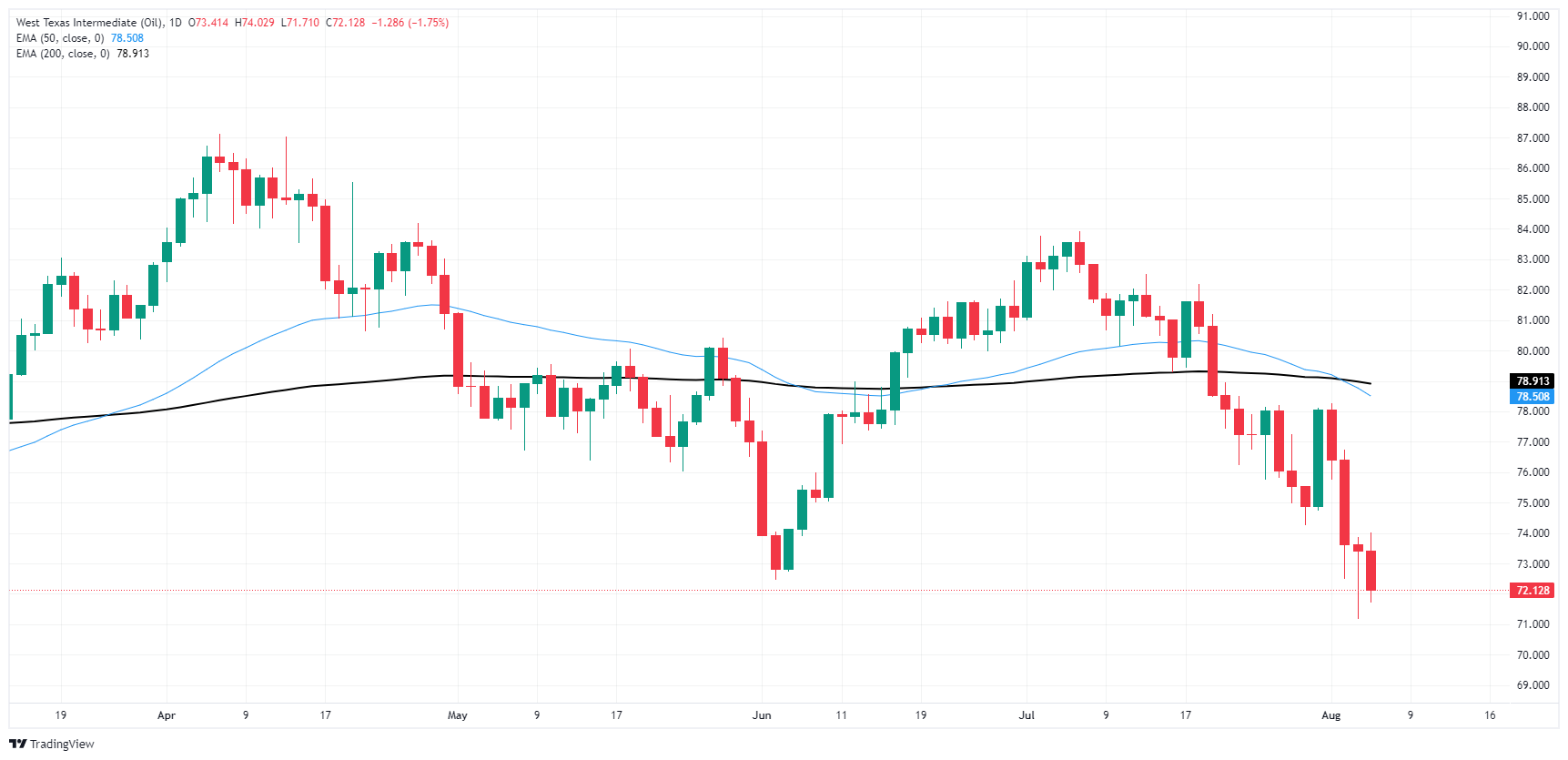- Analiza
- Novosti i instrumenti
- Vesti sa tržišta
- Crude Oil unable to find a bid as WTI languishes below $73
Crude Oil unable to find a bid as WTI languishes below $73
- Crude Oil markets remain on the low side despite Middle East concerns.
- Declines in US barrel counts appear to have snapped after API supplies print.
- Crude Oil markets may have found a floor, but price pressure weigh.
West Texas Intermediate (WTI) US Crude Oil fell back below $73.00 per barrel on Tuesday as fossil markets struggle to find a foothold with barrel bids firmly entrenched in the low side after a four-week tumble.
The American Petroleum Institute (API) released their Weekly Crude Oil Stock counts for the week ended August 2, reporting a thin 180K buildup in US barrel counts. Still, the figure looks set to end a multi-week run of sharp declines in US Crude Oil supplies after last week showed a -4.495 million barrel contraction. Crude Oil traders will be looking ahead to the Energy Information Administration’s (EIA) own Crude OIl supplies counts reported on Wednesday.
The ongoing Israel-Palestinian Hamas conflict threatened to bubble over last weekend after two suspected assassinations of Iranian Hezbollah officials. Iran has publicly vowed direct retaliation against Israel for the killings, prompting a naval reaction from US forces to move into the region in advance of any Iranian operations. Despite the significant uptick in geopolitical tensions, Crude Oil markets are having a difficult time finding the bidding pedal, and barrel prices remain subdued.
WTI technical outlook
With US Crude Oil on the backfoot and on pace early to chalk in a fifth straight week of declines, WTI has crumbled back below $73.00 per barrel, though technical pressure has built up to keep bids buoyed over $71.00 as of the time of writing. Price action is tilted firmly towards the downside, with daily candlesticks declining -15.00% peak-to-trough from July’s early peak of $83.93 per barrel.
WTI daily chart
WTI Oil FAQs
WTI Oil is a type of Crude Oil sold on international markets. The WTI stands for West Texas Intermediate, one of three major types including Brent and Dubai Crude. WTI is also referred to as “light” and “sweet” because of its relatively low gravity and sulfur content respectively. It is considered a high quality Oil that is easily refined. It is sourced in the United States and distributed via the Cushing hub, which is considered “The Pipeline Crossroads of the World”. It is a benchmark for the Oil market and WTI price is frequently quoted in the media.
Like all assets, supply and demand are the key drivers of WTI Oil price. As such, global growth can be a driver of increased demand and vice versa for weak global growth. Political instability, wars, and sanctions can disrupt supply and impact prices. The decisions of OPEC, a group of major Oil-producing countries, is another key driver of price. The value of the US Dollar influences the price of WTI Crude Oil, since Oil is predominantly traded in US Dollars, thus a weaker US Dollar can make Oil more affordable and vice versa.
The weekly Oil inventory reports published by the American Petroleum Institute (API) and the Energy Information Agency (EIA) impact the price of WTI Oil. Changes in inventories reflect fluctuating supply and demand. If the data shows a drop in inventories it can indicate increased demand, pushing up Oil price. Higher inventories can reflect increased supply, pushing down prices. API’s report is published every Tuesday and EIA’s the day after. Their results are usually similar, falling within 1% of each other 75% of the time. The EIA data is considered more reliable, since it is a government agency.
OPEC (Organization of the Petroleum Exporting Countries) is a group of 13 Oil-producing nations who collectively decide production quotas for member countries at twice-yearly meetings. Their decisions often impact WTI Oil prices. When OPEC decides to lower quotas, it can tighten supply, pushing up Oil prices. When OPEC increases production, it has the opposite effect. OPEC+ refers to an expanded group that includes ten extra non-OPEC members, the most notable of which is Russia.
© 2000-2024. Sva prava zaštićena.
Sajt je vlasništvo kompanije Teletrade D.J. LLC 2351 LLC 2022 (Euro House, Richmond Hill Road, Kingstown, VC0100, St. Vincent and the Grenadines).
Svi podaci koji se nalaze na sajtu ne predstavljaju osnovu za donošenje investicionih odluka, već su informativnog karaktera.
The company does not serve or provide services to customers who are residents of the US, Canada, Iran, The Democratic People's Republic of Korea, Yemen and FATF blacklisted countries.
Izvršenje trgovinskih operacija sa finansijskim instrumentima upotrebom marginalne trgovine pruža velike mogućnosti i omogućava investitorima ostvarivanje visokih prihoda. Međutim, takav vid trgovine povezan je sa potencijalno visokim nivoom rizika od gubitka sredstava. Проведение торговых операций на финанcовых рынках c маржинальными финанcовыми инcтрументами открывает широкие возможноcти, и позволяет инвеcторам, готовым пойти на риcк, получать выcокую прибыль, но при этом неcет в cебе потенциально выcокий уровень риcка получения убытков. Iz tog razloga je pre započinjanja trgovine potrebno odlučiti o izboru odgovarajuće investicione strategije, uzimajući u obzir raspoložive resurse.
Upotreba informacija: U slučaju potpunog ili delimičnog preuzimanja i daljeg korišćenja materijala koji se nalazi na sajtu, potrebno je navesti link odgovarajuće stranice na sajtu kompanije TeleTrade-a kao izvora informacija. Upotreba materijala na internetu mora biti praćena hiper linkom do web stranice teletrade.org. Automatski uvoz materijala i informacija sa stranice je zabranjen.
Ako imate bilo kakvih pitanja, obratite nam se pr@teletrade.global.















